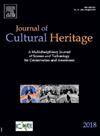日本传统滑动门湿致翘曲机理的实验与仿真研究
IF 3.3
2区 综合性期刊
0 ARCHAEOLOGY
引用次数: 0
摘要
fusuma是一种传统的日本装置,它是一种滑动门,经常展示纸上的绘画。但是,由于fusuma也是建筑构件,因此经常在保温性和气密性较低的寺庙、神社、城堡等文化遗产建筑内保存和展出;因此,温度和湿度的波动可能会导致漆纸变形和撕裂。本研究的重点是文物建筑内保存展出的fusuma画作的变形机理。具体而言,本研究研究了tobusuma(一种通过在一侧附加胶合板或碳纤维增强塑料(CFRP)板等支撑物来增加强度的fusuma)在前后发生温度和湿度差异时的翘曲行为,阐明了翘曲机制,并评估了不同支撑物类型对翘曲的影响。在实验中,制作了一个实际尺寸的tobusuma,并通过将其前后表面置于不同的温度和相对湿度下来测量翘曲度。此外,我们使用有限元法(FEM)模拟再现了我们的实验结果,并分析了每个tobusuma组件对翘曲的影响。结果表明,在两侧温度相同的情况下,tobusuma倾向于向相对湿度较高的方向翘曲,翘曲的方向和幅度取决于支撑类型。胶合板支架内部潮湿时挠曲较大,而碳纤维布支架由于透湿性低,外部潮湿时挠曲较大;然而,当外部是潮湿的,翘曲量是相似的两个支持。在典型的现场环境中,内部通常更稳定,湿度更低,支撑类型可能对翘曲的影响有限。在有限元模拟中,碳纤维布支架的模拟模型的再现性低于胶合板支架,这被认为是由于力学边界条件和部件的含水率输入的不确定性。特别是当构件的湿热性能差异较大时,如CFRP,进行水分传递与湿致力学变形模拟之间的耦合更为重要。研究结果有助于选择合适的支持来保存fusuma画作,并调查它们安装的环境。为了更深入地了解漆包画的变质机理,不仅需要对漆包画的翘曲进行研究,还需要对漆包画的变形行为和漆包画的变色/褪色进行研究。由于这些现象与温度、湿度、光照、紫外线等环境因素密切相关,我们认为,通过逐步弄清这些劣化机制,可以在环境波动的情况下为文物建筑提供最佳的保护和展示方法。本文章由计算机程序翻译,如有差异,请以英文原文为准。
Experimental and simulation studies on the mechanism of moisture-induced warping of traditional Japanese sliding doors
As a traditional Japanese fixture, fusuma is sliding doors, often displaying paintings on paper. However, because fusuma is also building components, it is often preserved and exhibited inside cultural heritage buildings, such as temples, shrines, and castles, which have low thermal insulation and airtightness; therefore, fluctuations in temperature and humidity may cause deformation of fusuma and tears in painted paper. This study focused on the deformation mechanisms of fusuma paintings preserved and exhibited inside cultural property buildings. Specifically, the study investigated the warping behavior of tobusuma—a type of fusuma made by attaching a support such as plywood or carbon fiber reinforced plastic (CFRP) board to one side to increase strength—when temperature and humidity differences occur on the front and back, clarified the warping mechanism, and evaluated the effect of different support types on warpage. In the experiment, an actual-sized tobusuma was prepared, and warpage was measured by subjecting its front and back surfaces to different temperatures and relative humidity. Additionally, we reproduced our experimental results using a finite element method (FEM) simulation and analyzed the effect of each tobusuma component on the warpage. The results showed that tobusuma tends to warp toward higher relative humidity if temperatures on both sides are the same, and that the direction and magnitude of warpage depend on the support type. For the plywood support, greater warpage occurred when the interior side was humid, whereas for the CFRP support, greater warpage occurred when the exterior side was humid because of its low moisture permeability; however, when the exterior side was humid, the amout of warpage was similar for both supports. In typical field environments, where the interior is generally more stable and less humid, the type of support may have a limited impact on warping. In the FEM simulation, the reproducibility of the simulation model was lower for the CFRP support than for the plywood support, which is considered to be due to uncertainties in the mechanical boundary conditions and moisture content input of the components. In particular, when the hygrothermal properties of components differ significantly, like CFRP, it is more important to perform coupling between moisture transfer and moisture-induced mechanical deformation simulation. The study results contribute to the selection of suitable support for preserving fusuma paintings and to investigation of environments in which they are installed. For a deeper understanding of fusuma paintings’ deterioration mechanism, it is necessary to investigate not only the warping of tobusuma but also the deformation behavior of painted paper and the discoloration/fading of the paintings. Since these phenomena are closely related to environmental factors such as temperature, humidity, illumination, and ultraviolet light levels, we consider that clarifying these deterioration mechanisms step by step will lead to the suggestion for optimal preservation and exhibition methods inside cultural property buildings with environmental fluctuations.
求助全文
通过发布文献求助,成功后即可免费获取论文全文。
去求助
来源期刊

Journal of Cultural Heritage
综合性期刊-材料科学:综合
CiteScore
6.80
自引率
9.70%
发文量
166
审稿时长
52 days
期刊介绍:
The Journal of Cultural Heritage publishes original papers which comprise previously unpublished data and present innovative methods concerning all aspects of science and technology of cultural heritage as well as interpretation and theoretical issues related to preservation.
 求助内容:
求助内容: 应助结果提醒方式:
应助结果提醒方式:


